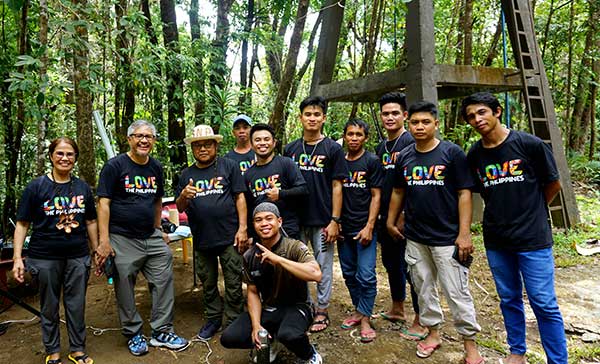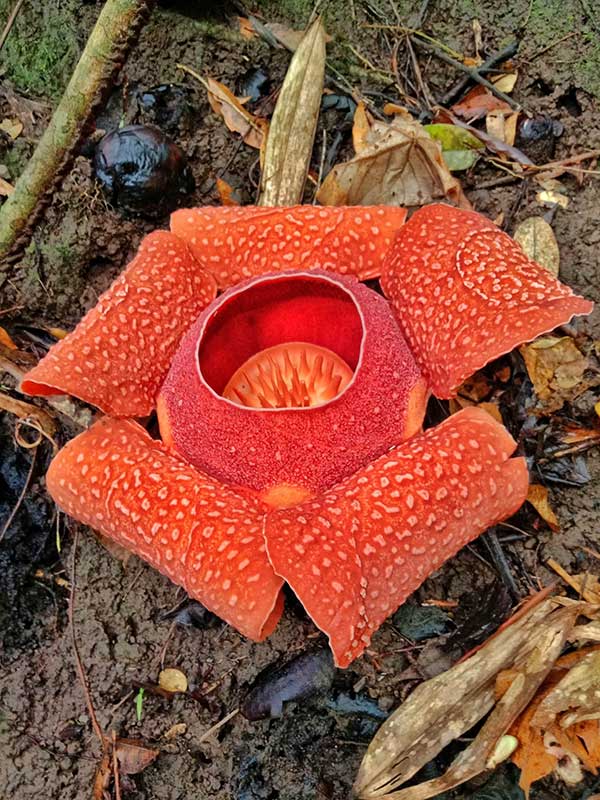ANTIQUE, PANAY – Lively Kinaray-a songs fill the air as ladies in vibrant floral skirts welcome visitors to Imparayan, one of 18 villages ringing the Sibalom Natural Park in Panay.
Arriving guests are festooned with leis fashioned to resemble giant Rafflesia, the park’s symbol. Home to a variety of wildlife and the Philippines’ Rainbow River, the park has just launched a new ecotourism package, designed and run by the local community.
“Welcome to the park and please remember our rules: no littering, smoking or taking of stones, plants or animals,” explains smiling guide Lumen Tiongco before we embark. “Talk gently along the trails to not disturb birds and lizards. Most importantly, have a good time.”
Our first stop is a quaint Rizalista Chapel established in 1975. Rizalistas believe in the divinity of Jose Rizal, believing our bowler-hat-clad hero is an incarnation of the Holy Spirit. Various folk beliefs abound here, with our guides doling out tiny pieces of ginger to affix to our clothes to appease forest spirits (we got back okay, so they probably worked).
Next is Bato Pispis, an eroded cliff with a pattern that looks somewhat like a bird with its wings outstretched. Swallows zoom above, stalking insects and building tiny nests on the sheer cliff. We take snaps and continue, crossing a bright red bridge and climbing a small hill to reach the Protected Area Management Office (PAMO), where a feast, friendly faces and comfortable accommodations await.
The PAMO is the control center of the Sibalom Natural Park, a 6,778.44-hectare park denuded by the Second World War and declared as a protected area in 2000. “In the 1970s, the park was reforested with a combination of commercially-valuable exotic tree species and local flora,” explains Sibalom Park Deputy Superintendent Joery Oczon. “Aside from the ‘Big Five’ – the Visayan Spotted Deer and Warty Pig, Walden’s and Tarictic hornbills, plus of course the giant Rafflesia – guests might encounter other types of flora and fauna, ranging from giant Lauaan trees to playful monkeys.”
The park also boasts of possibly the most colorful river in the Philippines, the Rainbow River, which brims with jade, quartz, onyx and other semi-precious stones – though park rangers constantly remind guests that stones cannot be taken.
Leveling Up Ecotourism Packages
Since 2022, the Department of Environment and Natural Resources (DENR), Department of Tourism (DOT), United Nations Development Programme’s Biodiversity Finance Initiative (UNDP-BIOFIN), local government of Antique province and local communities have been working to develop a world-class ecotourism package, developed and administered by residents living around the Sibalom Park.
“Local people know their area best, so they’re the ones who should identify and develop tourism spots,” explains Boboi Costas, who previously helped develop Cebu’s Bojo-Aloguinsan Mangrove River Tour, which won the Best Tourism Village Award from the United Nations World Tourism Organization in 2021. “We distilled the best lessons from Aloguinsan to help develop Sibalom’s tour package, which we hope can be replicated across the country.”
To ‘level up’ the community’s ecotourism skills, UNDP-BIOFIN organized a series of workshops covering topics like sustainable ecotourism management, strategic planning for tourism, designing tour experiences, food and beverage preparation, women’s empowerment, financial management, housekeeping, marketing, promotions and tour safety. Participants were drawn mainly from the Imparayan Bantay Gubat Association, comprised of around 80 local volunteers who regularly help clean and patrol the park.
“Communities that provide the infrastructure for tourism can earn not just from guiding, but the provision of meals, lodging, crafts and souvenirs,” explains Anabelle Plantilla, UNDP-BIOFIN Philippines National Project Manager. Properly done, ecotourism combines conservation and livelihood generation. “True sustainable development benefits everyone involved – local residents, tour operators, service providers and of course, the environment itself. We envision better lives for all. Walang maiiwan: no one gets left behind.”
The development of Sibalom’s community-led tours was an offshoot of the government’s and UNDP-BIOFIN’s Year of the Protected Areas (YoPA) Campaign, designed to boost visits to the country’s 247 protected areas. More visits generate much-needed funds for park salaries and equipment, plus the maintenance and improvement of facilities.
Active in over 40 countries, UNDP-BIOFIN has been working since 2012 to help bridge the enormous gap needed to fund the world’s biodiversity projects, estimated by the Nature Conservancy, Paulson Institute and Cornell University to amount to USD800 billion in 2020.
UNDP-BIOFIN has been working in the Philippines since 2014, working closely with the DENR and many allies to finance the Philippine Biodiversity Strategy and Action Plan (PBSAP), the country’s roadmap to conserve biodiversity. Its current target is to narrow down the national budget gap for environmental projects, estimated at PHP19 billion yearly. Finance initiatives like the Sibalom Park’s new ecotourism packages can help bridge this gap.
* * *
At the PAMO, guests enjoy local delicacies like chicken Porbida and Papisik. Everyone catches a breath after the morning trek, enjoying the cool forest air, the birdsongs around us.
“The Sibalom Natural Park is just one of many breathtaking places to visit in the Visayas,” says Krisma Rodriguez, Department of Tourism Regional Director for Western Visayas. “We invite everyone to see not just Sibalom in Antique – but Guimaras, Iloilo, Aklan, Capiz, Negros Occidental and the other tour destinations of our region.”
After a sumptuous lunch and a quick programme, we trek back through a forest of tall mahogany trees to Indaga Creek, ending at the Mau-It or Rainbow River, which sits beside a road. As we complete the tour while savoring cups of locally grown coffee, the head guide approaches our tired, satisfied group.
“There are many more places we want to show you, like Bato Kipot, Lake Pako and the Tipuluan River,” says Rowelo Esponilla, Imparayan Bantay Gubat Association President turned tour guide. “I work in construction, so guiding is a big help for me and my family. We hope more people come to see the beauty of the Sibalom Natural Park, where we’ll be ready to provide first-class service. There’s so much we want our guests to experience.”
The eco-tour’s launch was held ahead of the 24th observance of the International Day for Biological Diversity, celebrated each 22 May.
“By patronizing our protected areas, we can all ‘be part of the plan’ to reverse the loss of biodiversity,” concludes Plantilla. “Everyone has an important role to play.”
To visit the Sibalom Natural Park, email [email protected] or call +63926 358 1404. The park is four hours away from Boracay Island, two hours away from Iloilo City or 30 minutes from the Antique Airport in San Jose Buenavista.
































